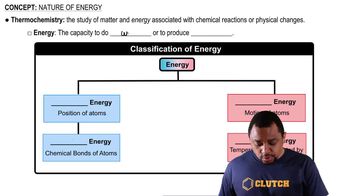The following do not represent valid ground-state electron configurations for an atom either because they violate the Pauli exclusion principle or because orbitals are not filled in order of increasing energy. Indicate which of these two principles is violated in each example. (b) 3Xe46s3
Certain elements emit light of a specific wavelength when they are burned or heated in a non-luminous flame. Historically, chemists used such emission wavelengths to determine whether specific elements were present in a sample. Some characteristic wavelengths for a few of the elements are given in the following table: Ag 328.1 nm Fe 372.0 nm Au 267.6 nm K 404.7 nm Ba 455.4 nm Mg 285.2 nm Ca 422.7 nm Na 589.6 nm Cu 324.8 nm Ni 341.5 nm (c) When burned, a sample of an unknown substance is found to emit light of frequency 6.58 * 1014 s-1. Which of these elements is probably in the sample?

Verified Solution
Key Concepts
Emission Spectra

Wavelength and Frequency Relationship

Quantization of Energy Levels

The following electron configurations represent excited states. Identify the element and write its ground-state condensed electron configuration. (b) 3Ne43s13p44p1.
If a sample of calcium chloride is introduced into a nonluminous flame, the color of the flame turns to orange ('flame test'). The light is emitted because calcium atoms become excited; their return to the ground state results in light emission. (b) What is the energy of 1.00 mol of these photons (a mole of photons is called an Einstein)?
In January 2006, the New Horizons space probe was launched from Earth with the mission to perform a flyby study of Pluto. The arrival at the dwarf planet was estimated to happen after nine years, in 2015. The distance between Earth and Pluto varies depending on the location of the planets in their orbits, but at their closest, the distance is 4.2 billion kilometers (2.6 billion miles). Calculate the minimum amount of time it takes for a transmitted signal from Pluto to reach the Earth.
The watt is the derived SI unit of power, the measure of energy per unit time: 1 W = 1 J>s. A semiconductor laser in a DVD player has an output wavelength of 650 nm and a power level of 5.0 mW. How many photons strike the DVD surface during the playing of a DVD 90 minutes in length?
In an experiment to study the photoelectric effect, a scientist measures the kinetic energy of ejected electrons as a function of the frequency of radiation hitting a metal surface. She obtains the following plot. The point labeled 'n0' corresponds to light with a wavelength of 542 nm. (a) What is the value of n0 in s - 1?
